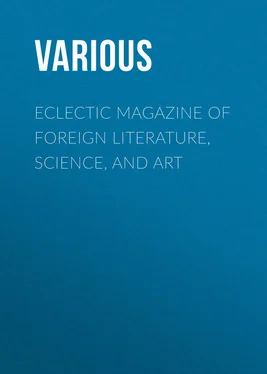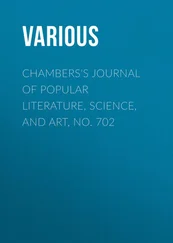Various - Eclectic Magazine of Foreign Literature, Science, and Art
Здесь есть возможность читать онлайн «Various - Eclectic Magazine of Foreign Literature, Science, and Art» — ознакомительный отрывок электронной книги совершенно бесплатно, а после прочтения отрывка купить полную версию. В некоторых случаях можно слушать аудио, скачать через торрент в формате fb2 и присутствует краткое содержание. Жанр: foreign_home, на английском языке. Описание произведения, (предисловие) а так же отзывы посетителей доступны на портале библиотеки ЛибКат.
- Название:Eclectic Magazine of Foreign Literature, Science, and Art
- Автор:
- Жанр:
- Год:неизвестен
- ISBN:нет данных
- Рейтинг книги:4 / 5. Голосов: 1
-
Избранное:Добавить в избранное
- Отзывы:
-
Ваша оценка:
- 80
- 1
- 2
- 3
- 4
- 5
Eclectic Magazine of Foreign Literature, Science, and Art: краткое содержание, описание и аннотация
Предлагаем к чтению аннотацию, описание, краткое содержание или предисловие (зависит от того, что написал сам автор книги «Eclectic Magazine of Foreign Literature, Science, and Art»). Если вы не нашли необходимую информацию о книге — напишите в комментариях, мы постараемся отыскать её.
Eclectic Magazine of Foreign Literature, Science, and Art — читать онлайн ознакомительный отрывок
Ниже представлен текст книги, разбитый по страницам. Система сохранения места последней прочитанной страницы, позволяет с удобством читать онлайн бесплатно книгу «Eclectic Magazine of Foreign Literature, Science, and Art», без необходимости каждый раз заново искать на чём Вы остановились. Поставьте закладку, и сможете в любой момент перейти на страницу, на которой закончили чтение.
Интервал:
Закладка:
A refracting telescope three feet in aperture collects rather more light than a speculum of four feet. 4 4 Silvered glass is considerably more reflective than speculum-metal, and Mr. Common’s 36-inch mirror can be but slightly inferior in luminous capacity to the Lick objective. It is, however, devoted almost exclusively to celestial photography, in which it has done splendid service. The Paris 4-foot mirror bent under its own weight when placed in the tube in 1875, and has not since been remounted.
In this quality, then, the Lick instrument will have – besides the Rosse leviathan, which, for many reasons, may be considered to be out of the running – but one rival. And over this rival – the 48-inch reflector of the Melbourne observatory – it will have all the advantages of agility and robustness (so to speak) which its system of construction affords; while the exquisite definition for which Alvan Clark is famous will, presumably, not be absent.
Already preparations are being made for its reception at Mount Hamilton. The scabrous summit of “Observatory Peak” has been smoothed down to a suitable equality of surface by the removal of 40,000 tons of hard trap rock. Preliminary operations for the erection of a dome, 75 feet in diameter, to serve as its shelter, are in progress. The water-supply has been provided for by the excavation of great cisterns. Buildings are rapidly being pushed forward from designs prepared by Professors Holden and Newcomb. Most of the subsidiary instruments have for some time been in their places, constituting in themselves an equipment of no mean order. With their aid Professor Holden and Mr. Burnham observed the transit of Mercury of November 7th, 1881, and Professor Todd obtained, December 6th, 1882, a series of 147 photographs (of which seventy-one were of the highest excellence) recording the progress of Venus across the face of the sun.
We are informed that a great hotel will eventually add the inducement of material well-being to those of astronomical interest and enchanting scenery. No more delightful summer resort can well be imagined. The road to the summit, of which the construction formed the subject of a species of treaty between Mr. Lick and the county of Santa Clara in 1875, traverses from San José a distance, as a bird flies, of less than thirteen miles, but doubled by the windings necessary in order to secure moderate gradients. So successfully has this been accomplished, that a horse drawing a light waggon can reach the observatory buildings without breaking his trot. 5 5 E. Holden, “The Lick Observatory,” Nature, vol. xxv. p. 298.
As the ascending track draws its coils closer and closer round the mountain, the view becomes at every turn more varied and more extensive. On one side the tumultuous coast ranges, stooping gradually to the shore, magnificently clad with forests of pine and red cedar; the island-studded bay of San Francisco, and, farther south, a shining glimpse of the Pacific; on the other, the thronging pinnacles of the Sierras – granite needles, lava-topped bastions – fire-rent, water-worn; right underneath, the rich valleys of Santa Clara and San Joaquim, and, 175 miles away to the north (when the sapphire of the sky is purest), the snowy cone of Mount Shasta.
Thus, there seems some reason to apprehend that Mount Hamilton, with its monster telescope, may become one of the show places of the New World. Absit omen! Such a desecration would effectually mar one of the fairest prospects opened in our time before astronomy. The true votaries of Urania will then be driven to seek sanctuary in some less accessible and less inviting spot. Indeed, the present needs of science are by no means met by an elevation above the sea of four thousand and odd feet, even under the most translucent sky in the world. Already observing stations are recommended at four times that altitude, and the ambition of the new species of climbing astronomers seems unlikely to be satisfied until he can no longer find wherewith to fill his lungs (for even an astronomer must breathe), or whereon to plant his instruments.
This ambition is no casual caprice. It has grown out of the growing exigencies of celestial observation.
From the time that Lord Rosse’s great reflector was pointed to the sky in February, 1845, it began to be distinctly felt that instrumental power had outrun its opportunities. To the sounding of further depths of space it came to be understood that Atlantic mists and tremulous light formed an obstacle far more serious than any mere optical or mechanical difficulties. The late Mr. Lassell was the first to act on this new idea. Towards the close of 1852 he transported his beautiful 24-inch Newtonian to Malta, and, in 1859-60, constructed, for service there, one of four times its light capacity. Yet the chief results of several years’ continuous observation under rarely favorable conditions were, in his own words, “rather negative than positive.” 6 6 Monthly Notices, R. Astr. Soc. vol. xiv. p. 133 (1854).
He dispelled the “ghosts” of four Uranian moons which had, by glimpses, haunted the usually unerring vision of the elder Herschel, and showed that our acquaintance with the satellite families of Saturn, Uranus, and Neptune must, for the present at any rate, be regarded as complete; but the discoveries by which his name is chiefly remembered were made in the murky air of Lancashire.
The celebrated expedition to the Peak of Teneriffe, carried out in the summer of 1856 by the present Astronomer Royal for Scotland, was an experiment made with the express object of ascertaining “how much astronomical observation can be benefited by eliminating the lower third or fourth part of the atmosphere.” 7 7 Phil. Trans. vol. cxlviii. p. 455.
So striking were the advantages of which it seemed to hold out the promise, that we count with surprise the many years suffered to elapse before any adequate attempt was made to realize them. 8 8 Captain Jacob unfortunately died August 16, 1862, when about to assume the direction of a hill observatory at Poonah.
Professor Piazzi Smyth made his principal station at Guajara, 8,903 feet above the sea, close to the rim of the ancient crater from which the actual peak rises to a further height of more than 3,000 feet. There he found that his equatorial (five feet in focal length) showed stars fainter by four magnitudes than at Edinburgh. On the Calton Hill the companion of Alpha Lyræ (eleventh magnitude) could never, under any circumstances, be made out. At Guajara it was an easy object twenty-five degrees from the zenith; and stars of the fourteenth magnitude were discernible. Now, according to the usual estimate, a step downwards from one magnitude to another means a decrease of lustre in the proportion of two to five. A star of the fourteenth order of brightness sends us accordingly only 1/39th as much light as an average one of the tenth order. So that, in Professor Smyth’s judgment, the grasp of his instrument was virtually multiplied thirty-nine times by getting rid of the lowest quarter of the atmosphere. 9 9 The height of the mercury at Guajara is 21·7 to 22 inches.
In other words (since light falls off in intensity as the square of the distance of its source increases), the range of vision was more than sextupled, further depths of space being penetrated to an extent probably to be measured by thousands of billions of miles!
This vast augmentation of telescopic compass was due as much to the increased tranquillity as to the increased transparency of the air. The stars hardly seemed to twinkle at all. Their rays, instead of being broken and scattered by continual changes of refractive power in the atmospheric layers through which their path lay, travelled with relatively little disturbance, and thus produced a far more vivid and concentrated impression upon the eye. Their images in the telescope, with a magnifying power of 150, showed no longer the “amorphous figures” seen at Edinburgh, but such minute, sharply-defined discs as gladden the eyes of an astronomer, and seem, in Professor Smyth’s phrase, to “provoke” (as the “cocked-hat” appearance surely baffles) “the application of a wire-micrometer” for the purposes of measurement. 10 10 Phil. Trans. vol. cxlviii. p. 477.
Интервал:
Закладка:
Похожие книги на «Eclectic Magazine of Foreign Literature, Science, and Art»
Представляем Вашему вниманию похожие книги на «Eclectic Magazine of Foreign Literature, Science, and Art» списком для выбора. Мы отобрали схожую по названию и смыслу литературу в надежде предоставить читателям больше вариантов отыскать новые, интересные, ещё непрочитанные произведения.
Обсуждение, отзывы о книге «Eclectic Magazine of Foreign Literature, Science, and Art» и просто собственные мнения читателей. Оставьте ваши комментарии, напишите, что Вы думаете о произведении, его смысле или главных героях. Укажите что конкретно понравилось, а что нет, и почему Вы так считаете.












